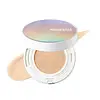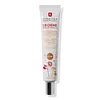What's inside
What's inside
 Key Ingredients
Key Ingredients

 Benefits
Benefits

 Concerns
Concerns

 Ingredients Side-by-side
Ingredients Side-by-side

Water
Skin ConditioningCI 77891
Cosmetic ColorantCyclopentasiloxane
EmollientEthylhexyl Methoxycinnamate
UV AbsorberMethyl Trimethicone
Skin ConditioningEthylhexyl Salicylate
UV AbsorberIsononyl Isononanoate
EmollientAlcohol Denat.
AntimicrobialButylene Glycol
HumectantPEG-10 Dimethicone
Skin ConditioningNiacinamide
SmoothingPentylene Glycol
Skin ConditioningSilica
AbrasiveSynthetic Fluorphlogopite
Bis-PEG/PPG-14/14 Dimethicone
EmollientHydrolyzed Vegetable Protein
Skin ConditioningTrimethylsiloxysilicate
EmollientDisteardimonium Hectorite
StabilisingMagnesium Sulfate
Isododecane
EmollientStearic Acid
CleansingAlumina
AbrasiveAcrylates/Polytrimethylsiloxymethacrylate Copolymer
Skin ConditioningTriethoxycaprylylsilane
Aluminum Hydroxide
EmollientEthylhexylglycerin
Skin ConditioningAdenosine
Skin ConditioningMaltodextrin
AbsorbentDisodium EDTA
Phenoxyethanol
PreservativeParfum
MaskingCI 77492
Cosmetic ColorantCI 77491
Cosmetic ColorantCI 77499
Cosmetic ColorantWater, CI 77891, Cyclopentasiloxane, Ethylhexyl Methoxycinnamate, Methyl Trimethicone, Ethylhexyl Salicylate, Isononyl Isononanoate, Alcohol Denat., Butylene Glycol, PEG-10 Dimethicone, Niacinamide, Pentylene Glycol, Silica, Synthetic Fluorphlogopite, Bis-PEG/PPG-14/14 Dimethicone, Hydrolyzed Vegetable Protein, Trimethylsiloxysilicate, Disteardimonium Hectorite, Magnesium Sulfate, Isododecane, Stearic Acid, Alumina, Acrylates/Polytrimethylsiloxymethacrylate Copolymer, Triethoxycaprylylsilane, Aluminum Hydroxide, Ethylhexylglycerin, Adenosine, Maltodextrin, Disodium EDTA, Phenoxyethanol, Parfum, CI 77492, CI 77491, CI 77499
Water
Skin ConditioningCyclomethicone
EmollientGlycerin
HumectantTitanium Dioxide
Cosmetic ColorantPEG-10 Dimethicone
Skin ConditioningDipropylene Glycol
HumectantEthylhexyl Methoxycinnamate
UV AbsorberDimethicone
EmollientTalc
AbrasiveIsoeicosane
EmollientZinc Oxide
Cosmetic ColorantHexyl Laurate
EmollientDisteardimonium Hectorite
StabilisingBetaine
HumectantPanax Ginseng Root Extract
EmollientGlycyrrhiza Glabra Root Extract
BleachingPortulaca Oleracea Extract
Skin ConditioningDioscorea Villosa Root Extract
Skin ConditioningEquisetum Giganteum Extract
Skin ConditioningKigelia Africana Fruit Extract
Skin ConditioningHydrogenated Starch Hydrolysate
HumectantEthylhexylglycerin
Skin ConditioningTocopheryl Acetate
AntioxidantMagnesium Sulfate
Silica
AbrasiveGlycosyl Trehalose
Emulsion StabilisingAluminum Hydroxide
EmollientPalmitic Acid
EmollientStearic Acid
CleansingPhenoxyethanol
PreservativeButylene Glycol
HumectantAcrylates/Dimethicone Copolymer
Skin ConditioningDimethicone/Vinyl Dimethicone Crosspolymer
Skin ConditioningMethicone
EmollientVinyl Dimethicone/Methicone Silsesquioxane Crosspolymer
Parfum
MaskingAlpha-Ionol
PerfumingIsomethyl-Beta-Ionone
PerfumingHexyl Cinnamal
PerfumingLinalool
PerfumingCitronellol
PerfumingGeraniol
PerfumingEugenol
PerfumingLimonene
PerfumingCI 77492
Cosmetic ColorantCI 77499
Cosmetic ColorantCI 77491
Cosmetic ColorantWater, Cyclomethicone, Glycerin, Titanium Dioxide, PEG-10 Dimethicone, Dipropylene Glycol, Ethylhexyl Methoxycinnamate, Dimethicone, Talc, Isoeicosane, Zinc Oxide, Hexyl Laurate, Disteardimonium Hectorite, Betaine, Panax Ginseng Root Extract, Glycyrrhiza Glabra Root Extract, Portulaca Oleracea Extract, Dioscorea Villosa Root Extract, Equisetum Giganteum Extract, Kigelia Africana Fruit Extract, Hydrogenated Starch Hydrolysate, Ethylhexylglycerin, Tocopheryl Acetate, Magnesium Sulfate, Silica, Glycosyl Trehalose, Aluminum Hydroxide, Palmitic Acid, Stearic Acid, Phenoxyethanol, Butylene Glycol, Acrylates/Dimethicone Copolymer, Dimethicone/Vinyl Dimethicone Crosspolymer, Methicone, Vinyl Dimethicone/Methicone Silsesquioxane Crosspolymer, Parfum, Alpha-Ionol, Isomethyl-Beta-Ionone, Hexyl Cinnamal, Linalool, Citronellol, Geraniol, Eugenol, Limonene, CI 77492, CI 77499, CI 77491
 Reviews
Reviews

Ingredients Explained
These ingredients are found in both products.
Ingredients higher up in an ingredient list are typically present in a larger amount.
Aluminum Hydroxide is a form of aluminum. It can be naturally found in nature as the mineral gibbsite. In cosmetics, Aluminum Hydroxide is used as a colorant, pH adjuster, and absorbent.
As a colorant, Aluminum Hydroxide may add opacity, or reduce the transparency. Aluminum hydroxide is contains both basic and acidic properties.
According to manufacturers, this ingredient is an emollient and humectant. This means it helps hydrate the skin.
In medicine, this ingredient is used to help relieve heartburn and help heal ulcers.
There is currently no credible scientific evidence linking aluminum hydroxide in cosmetics to increased cancer risk.
Major health organizations allow the use of aluminum hydroxide in personal care products and have not flagged it as a carcinogenic risk at typical usage levels.
Learn more about Aluminum HydroxideButylene Glycol (or BG) is used within cosmetic products for a few different reasons:
Overall, Butylene Glycol is a safe and well-rounded ingredient that works well with other ingredients.
Though this ingredient works well with most skin types, some people with sensitive skin may experience a reaction such as allergic rashes, closed comedones, or itchiness.
Learn more about Butylene GlycolCi 77491 is also hydrated iron III oxide. It's sole purpose is to give a red/pink hue to products.
Iron III oxides are classified as inorganic chemicals for coloring.
Synthetically created Ci 77491 is considered safer than those naturally found. This is because the synthetically created version may contain less impurities. Iron oxides are generally non-toxic and non-allergenic.
Learn more about CI 77491Ci 77492 is also hydrated iron III oxide. It's sole purpose is to give a yellow hue to products.
Iron III oxides are classified as inorganic chemicals for coloring.
Synthetically created Ci 77492 is considered safer than those naturally found. This is because the synthetically created version may contain less impurities. Iron oxides are generally non-toxic and non-allergenic.
Learn more about CI 77492Ci 77499 is also hydrated iron III oxide. It is created from mixing red and black iron oxides. This helps give shades of darkness to a product.
Iron III oxides are classified as inorganic chemicals for coloring.
Disteardimonium Hectorite comes from the clay mineral named hectorite. It is used to add thickness to a product.
It can also help stabilize a product by helping to disperse other ingredients.
Hectorite is a rare, white clay mineral.
Learn more about Disteardimonium HectoriteEthylhexyl Methoxycinnamate is an organic compound that provides UVB protection. It often goes by the more common name of octinoxate. It is created from methoxycinnamic acid and 2-ethylhexanol.
Ethylhexyl Methoxycinnamate absorbs UVB rays with wavelengths between 280-320 nm. UV absorbers protect your skin by using chemical reactions to convert UV rays into heat and energy.
UVB (290-320 nm) rays emit more energy than UVA rays. They are capable of damaging DNA, causing sunburns and are thought to be linked to skin cancer.
The state of Hawaii has banned sunscreens containing octinoxate due to its potential impact on coral reefs. More research is needed to bridge gaps in this research. The European Union allows higher levels of octinoxate in sunscreens than the US and Australia.
Ethylhexyl Methoxycinnamate is oil soluble. It is not stable and may lose efficacy when exposed to sunlight.
Learn more about Ethylhexyl MethoxycinnamateEthylhexylglycerin (we can't pronounce this either) is commonly used as a preservative and skin softener. It is derived from glyceryl.
You might see Ethylhexylglycerin often paired with other preservatives such as phenoxyethanol. Ethylhexylglycerin has been found to increase the effectiveness of these other preservatives.
Magnesium Sulfate is a salt. More specifically, it is an epsom salt, or the bath salt used to help relieve muscle aches.
Despite having ‘sulfate’ in the name, it isn’t a surfactant or cleansing agent like sodium lauryl sulfate. Unlike those sulfates, magnesium sulfate doesn’t have the same cleansing or foaming properties (it's simply a type of salt).
In cosmetics, Magnesium Sulfate is used to thicken a product or help dilute other solids. It is a non-reactive and non-irritating ingredient.
One study shows magnesium deficiency may lead to inflammation of the skin. Applying magnesium topically may help reduce inflammation.
You can find this ingredient in sea water or mineral deposits.
Learn more about Magnesium SulfateParfum is a catch-all term for an ingredient or more that is used to give a scent to products.
Also called "fragrance", this ingredient can be a blend of hundreds of chemicals or plant oils. This means every product with "fragrance" or "parfum" in the ingredients list is a different mixture.
For instance, Habanolide is a proprietary trade name for a specific aroma chemical. When used as a fragrance ingredient in cosmetics, most aroma chemicals fall under the broad labeling category of “FRAGRANCE” or “PARFUM” according to EU and US regulations.
The term 'parfum' or 'fragrance' is not regulated in many countries. In many cases, it is up to the brand to define this term.
For instance, many brands choose to label themselves as "fragrance-free" because they are not using synthetic fragrances. However, their products may still contain ingredients such as essential oils that are considered a fragrance by INCI standards.
One example is Calendula flower extract. Calendula is an essential oil that still imparts a scent or 'fragrance'.
Depending on the blend, the ingredients in the mixture can cause allergies and sensitivities on the skin. Some ingredients that are known EU allergens include linalool and citronellol.
Parfum can also be used to mask or cover an unpleasant scent.
The bottom line is: not all fragrances/parfum/ingredients are created equally. If you are worried about fragrances, we recommend taking a closer look at an ingredient. And of course, we always recommend speaking with a professional.
Learn more about ParfumPeg-10 Dimethicone is silicone with conditioner and emulsifier properties. It mostly acts as an emollient in skincare and and humectant in haircare.
According to the manufacturer, acidic formulations decrease the stability of this ingredient. It works best in neutral or near neutral formulations.
Phenoxyethanol is a preservative that has germicide, antimicrobial, and aromatic properties. Studies show that phenoxyethanol can prevent microbial growth. By itself, it has a scent that is similar to that of a rose.
It's often used in formulations along with Caprylyl Glycol to preserve the shelf life of products.
Silica, also known as silicon dioxide, is a naturally occurring mineral. It is used as a fine, spherical, and porous powder in cosmetics.
Though it has exfoliant properties, the function of silica varies depending on the product.
The unique structure of silica enhances the spreadability and adds smoothness, making it a great texture enhancer.
It is also used as an active carrier, emulsifier, and mattifier due to its ability to absorb excess oil.
In some products, tiny microneedles called spicules are made from silica or hydrolyzed sponge. When you rub them in, they lightly polish away dead skin layers and enhance the penetration of active ingredients.
Learn more about SilicaStearic Acid is a fatty acid. It is an emollient, emulsifier, and texture enhancer.
As an emollient, stearic acid helps soften skin. It aids the skin's protective barrier by preventing water loss. It also provides a gentle cleansing effect without stripping away natural oils.
Stearic acid may also be used to enhance the texture of products. It can add volume and stabilize ingredients such as water and oil. This can help water and oil ingredients from separating.
Sources of stearic acid include animal or vegetable fats/oils such as coconut or shea. It can be naturally found in butter, cocoa butter, shea butter, vegetable fats, and animal tallow.
This ingredient may not be Malassezia folliculitis, or fungal-acne safe.
Learn more about Stearic AcidWater. It's the most common cosmetic ingredient of all. You'll usually see it at the top of ingredient lists, meaning that it makes up the largest part of the product.
So why is it so popular? Water most often acts as a solvent - this means that it helps dissolve other ingredients into the formulation.
You'll also recognize water as that liquid we all need to stay alive. If you see this, drink a glass of water. Stay hydrated!
Learn more about Water